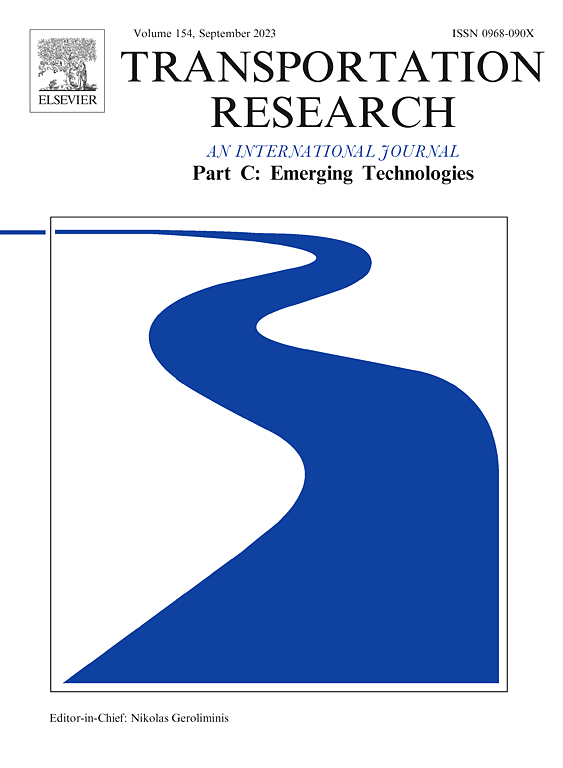MoGERNN: An inductive traffic predictor for unobserved locations
IF 7.6
1区 工程技术
Q1 TRANSPORTATION SCIENCE & TECHNOLOGY
Transportation Research Part C-Emerging Technologies
Pub Date : 2025-03-11
DOI:10.1016/j.trc.2025.105080
引用次数: 0
Abstract
Given a partially observed road network, how can we predict the traffic state of interested unobserved locations? Traffic prediction is crucial for advanced traffic management systems, with deep learning approaches showing exceptional performance. However, most existing approaches assume sensors are deployed at all locations of interest, which is impractical due to financial constraints. Furthermore, these methods are typically fragile to structural changes in sensing networks, which require costly retraining even for minor changes in sensor configuration. To address these challenges, we propose MoGERNN, an inductive spatio-temporal graph model with two key components: (i) a Mixture of Graph Experts (MoGE) with sparse gating mechanisms that dynamically route nodes to specialized graph aggregators, capturing heterogeneous spatial dependencies efficiently; (ii) a graph encoder-decoder architecture that leverages these embeddings to capture both spatial and temporal dependencies for comprehensive traffic state prediction. Experiments on two real-world datasets show MoGERNN consistently outperforms baseline methods for both observed and unobserved locations. MoGERNN can accurately predict congestion evolution even in areas without sensors, offering valuable information for traffic management. Moreover, MoGERNN is adaptable to the changes of sensor network, maintaining competitive performance even compared to its retrained counterpart. Tests performed with different numbers of available sensors confirm its consistent superiority, and ablation studies validate the effectiveness of its key modules. The code of this work is publicly available at: https://github.com/ZJU-TSELab/MoGERNN.
MoGERNN:对未观测位置的感应交通预测器
给定一个部分观察到的道路网络,我们如何预测感兴趣的未观察到的位置的交通状态?交通预测对于先进的交通管理系统至关重要,深度学习方法表现出优异的性能。然而,大多数现有方法假设传感器部署在所有感兴趣的位置,这是不切实际的,因为财政限制。此外,这些方法通常容易受到传感网络结构变化的影响,即使传感器配置的微小变化也需要昂贵的再培训。为了解决这些挑战,我们提出了MoGERNN,一个由两个关键组件组成的归纳时空图模型:(i)具有稀疏门控机制的混合图专家(MoGE),它可以动态地将节点路由到专门的图聚合器,有效地捕获异构空间依赖性;(ii)图形编码器-解码器架构,利用这些嵌入来捕获空间和时间依赖关系,以进行全面的交通状态预测。在两个真实数据集上的实验表明,MoGERNN在观察和未观察位置上始终优于基线方法。即使在没有传感器的地区,MoGERNN也能准确预测拥堵演变,为交通管理提供有价值的信息。此外,MoGERNN能够适应传感器网络的变化,即使与经过再训练的同类相比,也能保持竞争力。使用不同数量的可用传感器进行的测试证实了其一贯的优势,烧蚀研究验证了其关键模块的有效性。这项工作的代码可以在:https://github.com/ZJU-TSELab/MoGERNN上公开获得。
本文章由计算机程序翻译,如有差异,请以英文原文为准。
求助全文
约1分钟内获得全文
求助全文
来源期刊
CiteScore
15.80
自引率
12.00%
发文量
332
审稿时长
64 days
期刊介绍:
Transportation Research: Part C (TR_C) is dedicated to showcasing high-quality, scholarly research that delves into the development, applications, and implications of transportation systems and emerging technologies. Our focus lies not solely on individual technologies, but rather on their broader implications for the planning, design, operation, control, maintenance, and rehabilitation of transportation systems, services, and components. In essence, the intellectual core of the journal revolves around the transportation aspect rather than the technology itself. We actively encourage the integration of quantitative methods from diverse fields such as operations research, control systems, complex networks, computer science, and artificial intelligence. Join us in exploring the intersection of transportation systems and emerging technologies to drive innovation and progress in the field.

 求助内容:
求助内容: 应助结果提醒方式:
应助结果提醒方式:


